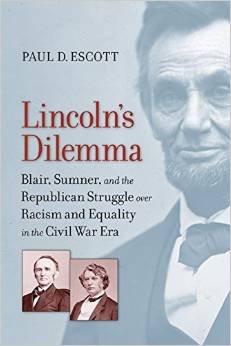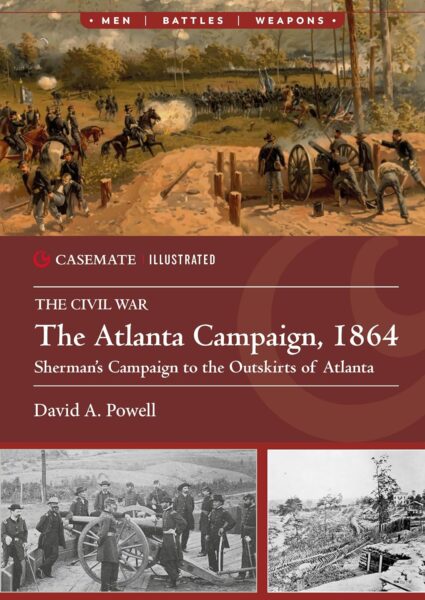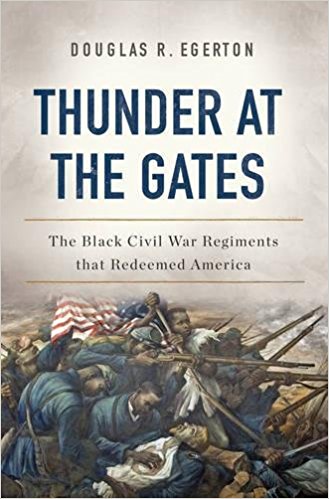Lincoln’s Dilemma: Blair, Sumner, and the Republican Struggle over Racism and Equality in the Civil War Era by Paul D. Escott. University of Virginia Press, 2014. Cloth, ISBN: 978-0-8139-3619-2. $29.95
 Paul D. Escott is a leading historian of the antebellum South and the Civil War. In Lincoln’s Dilemma: Blair, Sumner, and the Republican Struggle over Racism and Equality in the Civil War Era, however, he has extended his field of inquiry. Divided into a preface, introduction, and twenty-one chapters, his newest work explores both the connection between and the separation of slavery and racial prejudice in the mid-nineteenth century United States.
Paul D. Escott is a leading historian of the antebellum South and the Civil War. In Lincoln’s Dilemma: Blair, Sumner, and the Republican Struggle over Racism and Equality in the Civil War Era, however, he has extended his field of inquiry. Divided into a preface, introduction, and twenty-one chapters, his newest work explores both the connection between and the separation of slavery and racial prejudice in the mid-nineteenth century United States.
Abraham Lincoln occupies the central stage in Escott’s study, of course, but he shares that stage with three other men. The first two—Montgomery Blair and Charles Sumner—were, like Lincoln, anti-slavery men as well as pillars of the new Republican Party. John Wilkes Booth, the third man, was northern born, but a violent defender of slavery and white supremacy.
Slavery was a sectional institution by the 1850s, and most northerners were content that it remain so. At the same time, they increasingly opposed the expansion of the South’s “peculiar institution” into the western territories. The Republican Party was a manifestation of those attitudes.
Yet if Lincoln, Blair, and Sumner all agreed that human bondage should be confined to those states in which it already resided, there were also profound disagreements among these men over the ultimate consequences of abolition. Montgomery Blair and his family, for example, represented a conservative element within the Republican Party. They abandoned the Democracy after concluding that the party had become the instrument of a slave-owning aristocracy. At the same time, they retained the view that black people were morally and intellectually inferior. In the end, they believed that emancipation should be accompanied by a federal program of colonization.
Charles Sumner, on the other hand, was the exemplar of a smaller but extremely vocal segment of both the Republican Party and the white population of the North. Sumner championed immediate abolition and racial equality.
Lincoln found himself somewhere between these two. As a cautious and pragmatic politician, he recognized the strength of racial prejudice and the reluctance—even in the darkest days of the Civil War—for white northerners to accept African Americans as equal. His first duty, therefore, was to maintain harmony within his party and to use that harmony as an engine to restore the Union. This meant that Lincoln never permitted himself to advance too far in front of public opinion and sometimes lagged behind assuming the role of a prudent elder statesman.
Even so, Escott writes that a man as intelligent and experienced as Lincoln cannot be called “naïve,” but could be “unrealistically positive” (217) in his estimate of others. Too often, forced to seek a golden mean between contradictory and intractable positions, he sought refuge in vague language and ambiguity. As late as the final months of the war, for example, whether or not the abolition of slavery was a non-negotiable requirement for peace remained uncertain. Thus, he retained the support of both the Blair family and Charles Sumner.
Lincoln’s Dilemma: Blair, Sumner, and the Republican Struggle over Racism and Equality in the Civil War Era breaks little new ground. While its picture of the sixteenth president is less flattering and more nuanced than that of Carl Sandburg’s and other Lincoln hagiographers, students of the era have been aware of Lincoln’s flaws and human frailties for some time. The clarity of Paul Escott’s prose, however, together with his ability to tell a good story, will provide an audience of non-specialists with a greater understanding of Lincoln and his policies. Abraham Lincoln and the Civil War destroyed slavery in the United States, but racial prejudice was only a little discomforted. To recognize this reality, Escott concludes, “is to understand more truly both Lincoln’s achievements and the nation’s failure” (221).
Martin J. Hardeman is Associate Professor of History at Eastern Illinois University.




